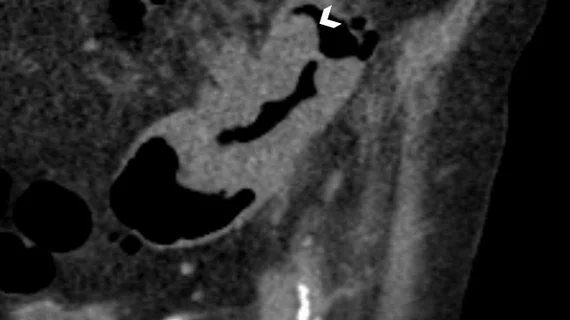Radiologists should be mindful of extracolonic findings on CTC scans of cancer patients
Extracolonic findings observed on computed tomography colonography (CTC) scans of cancer patients might identify undetected malignancy more often than previously thought, according to a new study.
Research published this week in Clinical Imaging that highlights the prevalence of extracolonic findings, as well as the clinical outcomes, found that more than 8% of CTC scans on oncological patients uncover “potentially important” imaging anomalies, which sometimes resulted in the discovery of previously unidentified cancers.
“While CT images provide critical information on the colon, they also yield information on extracolonic structures (from the lung bases to the pelvis) despite the low radiation dose and frequent lack of intravenous contrast,” corresponding author Marc J. Gollub, of the Department of Radiology at Memorial Memorial Sloan Kettering Cancer Center in New York, and co-authors said. “From the early days of CTC, radiologists have faced the dilemma of how to deal with extracolonic findings.”
While extracolonic findings have been researched in symptomatic patients or patients undergoing CTC cancer screenings, their frequency and impact on patients with cancer is relatively undetermined, the authors suggested. Since cancer patients frequently undergo imaging for surveillance, the researchers hypothesized that extracolonic findings in this population of individuals would be minimal compared to the general population.
They retrospectively analyzed CTC exams from 855 patients who underwent the scan between February 2000 and April 2016 with the help of two radiologists. One reader, who was blinded to the data, classified the extracolonic findings using C-RADS (E1-E4), while another unblinded radiologist also completed a review. The unblinded radiologist focused on E4, or “potentially important,” classifications when reviewing the medical records to determine if the findings were previously unknown and then reclassified them as either clinically important or unimportant.
Through these reviews, researchers uncovered results that contradicted their original hypothesis. They found that 19.8% of extracolonic findings were either incompletely characterized or potentially important. On follow-up, 8.3% had findings considered clinically important, 7.7% of which resulted in detection of previously unidentified malignancies found mostly in the pancreas, uterus, small bowel, ovaries and lungs.
“Overall, increased medical imaging, while potentially helpful for addressing the clinical question under review, carries with it the trade-off of new, unexpected findings unrelated to the primary question,” the authors explained. “Radiologists should be mindful that the evaluation of the extracolonic findings is as crucial as the evaluation of colonic findings on CTC, even in oncological hospitals. Early detection of new metastases or new primary tumors, if resectable for example, could possibly lead to decreased morbidity.”
Related content on cancer screening:
These image findings on LDCT screenings offer insight beyond lung cancer
Mayo Clinic offers new guidance on supplemental screening of women with dense breasts
Breast cancer is overdiagnosed in 15% of screenings
Rural outreach initiative produces significant increase in lung cancer screenings

